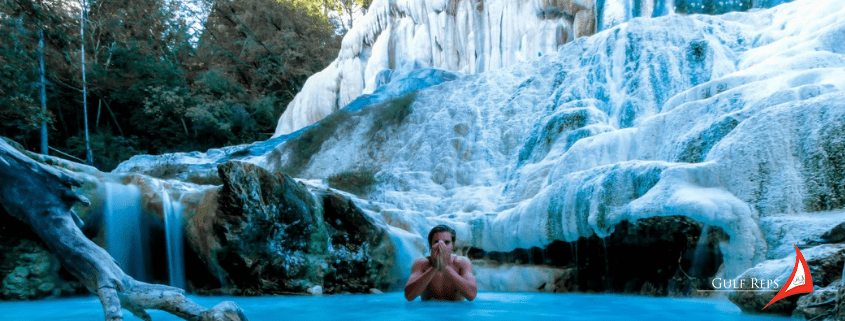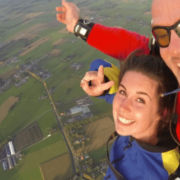Should You Provide Wellness Tourism Services?
Wellness tourism is on the rise. This blog discusses what wellness tourism is and what it isn’t. It also provides a few examples of existing wellness retreats and finally, it covers the advantages businesses can reap from investing in the sector or including wellness adaptations to their existing attractions.
What is Wellness Tourism?
According to the Global Wellness Institute (GWI), wellness tourism is “travel (that is) associated with the pursuit of maintaining or enhancing one’s personal wellbeing“. Often confused with medical tourism, wellness tourism is not concerned with combatting poor health or curing illnesses but is the proactive measure of preventing diseases, reducing stress, and promoting overall wellbeing.
Examples of Existing Wellness Tourism Attractions
Below are a few short descriptions of wellness tourism attractions.
Sand Baths
Under the hot sun of the Moroccan desert, with sand temperatures reaching 80° C, wellness tourists are burying themselves neck-deep into the sand in search of health benefits. The heat of the dry sand absorbs any excess moisture from their bodies, cleansing them and removing toxins in the process. The baths or “hammams” are also known to cure joint pains and help with bone diseases.
Walking Yoga Safaris
These occur either in the wilderness of African game park reserves or in concealed remote village outskirts. Walking Yoga Safaris are usually full-day excursions that center around meditation and yoga amid natural elements. Travelers are enveloped with a feeling of togetherness with the life they feel around them, be it greenery or wild animals.
In this wellness activity, the day starts with a sunrise meditation session around a natural landmark (a riverbank, the African savannah, or a lakeside). Then, a light breakfast is had, followed by a walk into the wilderness accompanying wildlife tracking experts. Later as the weather becomes hot, the guests are led back to their cottages for lunch and some rest.
In the early evening, visitors embark on another yoga/meditation session. Afterwards, they embark on another guided walk into nature and conclude by watching the sunset and gathering around a fire to chat and watch the stars.
Nordic Wellness Retreats
Drawing from the ancient wisdom of Nordic culture, Nordic wellness retreats aim to connect the mind and body with nature. Found all over Europe and not just Nordic countries, programs include various activities such as hiking in the forests, saunas sessions, dips in hot tubs, and lake swims. These activities are usually paired with dietary provisions such as traditional treatments (known for their healing capabilities), wild forage, and fresh game meals.
Individuals can engage in group retreats or isolate themselves and enjoy the region’s vast and open, quiet spaces. The latter option is made abundantly available in the private island cabins of Sweden, where individuals have a whole mini-island to themselves.
Furthermore, with the rise of the Wim Hof wellness program, individuals opting for a Nordic retreat may have the chance of meeting the Iceman himself and learning straight from the source about the now popular breathing and ice-emersion techniques.
The Value of the Wellness Tourism Sector and the Wellness Tourist
Combining the buying power of the highly profitable tourism and wellness industries, wellness tourism is a force to be reckoned with. Between 2015 to 2017, the growth rate of wellness tourism was twice the growth rate of regular tourism. The industry is still rapidly growing and is predicted to reach $919 billion this year, according to the GWI.
Furthermore, the wellness traveler is known to be a high spending traveler type. According to the Director of Research at GWI, Beth McGroarty, wellness travelers spend 178% more than the average traveler on domestic trips and 53% more on international trips.
Equinox Explore, Equinox’s brand extension into the wellness tourism sector, provided a four-day running tour in Florence for a cost that began at $2,350 in 2020. This was the cheapest of the experiences offered by the company then. The most expensive experience for that year was a six-day hiking trip in Morocco which started at $6,250.
Shifts in the Travel Industry
Destinations are beginning to employ a strategy that attracts a reasonable number of wellness tourists at high holiday prices instead of the large crowds of middle-class tourists typically needed to drive profits. Doing this reduces the adverse effects of mass tourism. It prevents the race-to-the-bottom style pricing strategies that occur when businesses have to compete for a travelers patronage of their product or service.
Furthermore, wellness offshoots can be set up in a primarily leisure locations as a secondary attraction to attract visitors in low-traffic seasons. A ski resort, for instance, would reap the benefits of setting up spas and mountain yoga retreats in the summer seasons. Thus, making a profit out of their downtime.
Wellness Traveler Demographics and Categories
Even though wellness travelers can be comprised of many different demographics, the majority seem to be highly educated and affluent females between the ages of 30 and 60 years. A further categorization divides these travelers into two divisions—primary wellness travelers, who travel solely for the purpose of wellness. And secondary wellness travelers who travel for leisure or business and happen to make wellness pit stops. These groups, however, are not mutually exclusive. For example, a primary wellness traveler can be a secondary wellness traveler on their current trip and then become a primary wellness traveler on the next. However, it’s worth noting that primary wellness travelers account for only 14% of wellness tourism spending, whereas secondary wellness travelers make up for 86%.
Wellness Tourism and Complementary Business Opportunities
Wellness travelers (especially seasoned ones) usually uphold a certain kind of lifestyle. A lifestyle that involves a specific dietary makeup, mind/body activities, and at times even a particular taste in fashion. Therefore, when a wellness traveler engages in a holiday in your destination, they not only put money into the retreat’s pocket, but they also help by contributing to the country’s/region’s GDP through purchases they make to maintain their lifestyle. This opens the door for destinations and surrounding businesses to capture more value from the wellness traveler by delivering more differentiated and targeted products and services.
Gulf Reps
Gulf Reps is the leading travel and destination representation company in the Middle East. We specialize in directing the Arab traveler to your destination or region. With over 60 years of experience in the field of travel representation, we’ve solidified a sturdy network of travel agencies, airlines, hotels and much more. With our electric mix of marketing activities, there isn’t a surer way to attract Arab travelers to your destination.
To find out more about our services, you can call us at +971 (0)4 703 6333 or write to us at sammy@gulfreps.com








